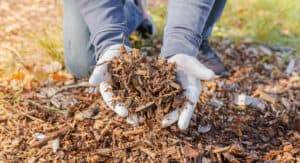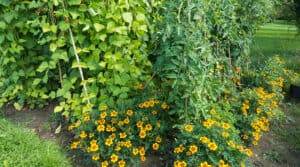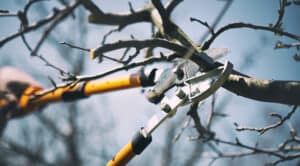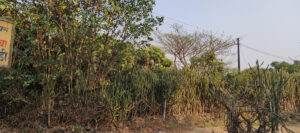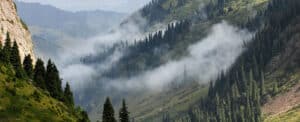When I moved to my current property in 2014, I set about turning an existing small stone-walled orchard into a forest garden. Having worked since on this, and on many forest garden designs for properties around the world, I truly and firmly believe that this concept, common in the permaculture movement, is key to developing the future that we all wish to see.
But if you have never heard of a food forest before, you may be confused by this term. You may wonder how much food one can really grow in a forest. If you are new to food forests, or forest gardens as they are sometimes also called, then this beginner’s guide should set you straight.
In this guide, I aim to help you understand this concept, see why creating a food forest of your own is such a wonderful idea, and learn how you might get started.
What is a Food Forest?
A food forest is a food-producing system filled with a range of predominantly perennial plants. Like a natural forest or woodland, it contains diverse, layered plant life. As in an entirely natural tree-based ecosystem, the plants, animals and fungi in a food forest work in harmony with one another.
But unlike a natural forest, a food forest is designed. We carefully select and place different plant species to not only create a natural symbiosis but also to provide us with food and other yields.
Food forests work naturally, mimicking natural systems and in harmony with the natural world. But the species within them are carefully selected to provide we humans with what we need. This outlook and emphasis on human need is what sets a food forest apart from a natural, native woodland.
Woodland or forest native to your region might provide a range of food and other yields. But not as intensively or to the same degree as a well-designed food forest, which will frequently start with native planting but which will often move beyond this to consider other plants, not necessarily native, that will be useful within the system, and to those who harvest from it.
The Layers of Food Forests
One of the key features of a food forest are the layers of planting within the system. The key layers of food forests are:
- Canopy trees
- Sub-canopy trees
- Shrubs
- Taller herbaceous plants
- Ground cover plants
- Bulbs, tubers, and other features of the root zone (rhizosphere) below the soil.
Climbers also ascend through these layers. Local wildlife interacts with the system. And people, too, have a role to play in the creation and evolution of the ecosystem over time.
The Benefits of Creating a Food Forest
One key goal in food forests is to maximize the potential of the sun’s energy by maximizing the number of plants that will grow successfully in a given area and the photosynthesis that takes place.
Layering plants in space, making use of the space below productive trees to grow other species, can increase the yield from a given area, and maximize biodiversity.
We want to maximize biodiversity because in any system, biodiversity increases not just the number of species, but the number of beneficial interactions between them. The more beneficial interactions there are within a system, the more stable and resilient that system will be, and the more likely it is to endure successfully over time.
Like traditional annual vegetable gardens, or other predominantly annual growing systems, food forests can provide people with plenty of food and other resources. However, they also:
- Contain trees, shrubs and other perennial plants which effectively sequester carbon and help us draw-down greenhouse gases and fight our climate crisis.
- Protect and improve biodiversity and therefore help us fight biodiversity losses and care for the wildlife around us.
- Become largely self-sustaining systems once established, requiring minimal to no input, and far less work from the gardener than an annual food producing system.
If you want an earth-friendly, abundant, beautiful, productive and low-maintenance garden then creating a food forest may well be the best choice for you and your property.
Types of Food Forest
When you think about a forest, you might think of a large expanse of land covered with trees. But there are no limitations on the size of a food forest. A food forest can cover acres of land – or be a system with just a few small trees within a typical domestic backyard.
No matter the scale on which such a system is created, the general principles and practices remain the same. Whether you plant three trees, or three hundred, the goals will still be to create a bountiful system filled with layered planting that works harmoniously as a whole to provide for you, enhance the environment, and work for wildlife too.
Before you begin the process of actually designing a food forest you need to spend a little time determining the size and scale of your intended project, and what precisely you would like to achieve.
Think about whether, for example, you would like your food forest to double as an attractive and ornamental garden space, or whether maximizing the quantity of food that can be produced is your main goal.
Do you want to create a food forest that will be only for you and your immediate household, or are you looking to create a commercial enterprise?
Will you keep any livestock within the system as if so, care must be taken to protect certain species from foraging and grazing. And while certain animals may be beneficial, others may be too destructive to allow your layered planting to thrive.
With certain livestock, a different form of agroforestry might be better for areas of grazing. Food forests are one example of agroforestry. But agroforestry, (combining agriculture and forestry) might also take other forms.
Rather than creating a layered food forest, you might consider an agroforestry approach called silvo-pasture, which involves grazing livestock between productive trees. Or silvo-arable systems, in which common annual agricultural crops are grown between tree rows.
Once you have spent some time thinking about your goals, it might be time to begin designing your own specific food forest.
Designing Food Forests
When designing a food forest, the first and most important thing to remember is that not all food forests will look the same, and what works well in one location will not necessarily work as successfully in another.
In tropical and subtropical systems, trees are often placed much more closely, creating a high level of canopy cover. But in cooler, temperate climate zones, letting sunlight in through to the lower layers of the food forest is important, and the canopy cover typically won’t be as dense.
Observe – Design for Your Specific Site
Of course, whenever you plant anything on your property, good observational skills are key. As well as thinking about the climate, you also need to consider the micro-climate, topography, existing features and soil.
Mapping permaculture sectors and flow and looking at the broader patterns on your property should be the first step in determining your food forest system and, ultimately, which plants you will place within it.
Determining the Layout for a Food Forest
Since, in permaculture, we design from patterns to details, we need to consider the overall layout and positioning of the food forest and its key trees before we delve into the more intricate details of the design.
There are, of course, many different things to think about as we analyse sunshine, shade, wind, water and soil on a property. But beyond this, in forest garden design, it is also important to think about another important permaculture principle – maximizing edge.
The sunny fringes of your food forest (especially in a temperate climate) will be the most productive and biodiverse parts of the system. So creating a layout with as many of these sunny edges as possible will help you to make sure that your food forest is as successful and productive as possible.
Creating pathways to allow light to travel effectively into the food forest, and sunny glades within your design can help you make sure that you maximize the areas where plants that like the sunny fringes of the system will thrive.
Water Management in Food Forest Design
Working from the big-picture view – thinking about the flow and management of water on the site, as well as sunlight and other environmental factors will help ensure that your food forest gets off to the best possible start – with all the necessary groundwork in place.
In some instances, for example, trees might be planted in the berms on the downhill side of on-contour swales which catch and slow water flowing down a slope. Even where swales are not required, planting your productive trees on contour when working with slope can often be the best decision.
Plant Choices in Food Forest Design
Once you have the broad details in place, you can hone in on the details and begin to consider which species you will incorporate into your food forest design.
Typically, you will begin by choosing the key tree and shrub species. Remember, in addition to choosing those which provide fruits, nuts or edible leaves, you should also choose trees and shrubs that contribute to the establishment of the system, and help create optimal conditions for your productive plants to grow.
Nitrogen fixation is an important thing to think about in the creation of a food forest. Certain plants, called ‘nitrogen fixers’ co-operate with bacteria in their roots to take nitrogen from the atmosphere and make it available in the soil. Some of the nitrogen is used by the plant itself, but some is made available through the soil to other plants growing nearby.
Incorporating plenty of nitrogen-fixing species is important in the creation of a food forest. Choosing nitrogen-fixing species native to your area is often a good policy, and it is important to avoid species which may be invasive where you live.
Once you have chosen your key nitrogen-fixing species and key productive shrub and tree species, it is time to think about all the lower layers of the system.
The goal is to create polycultures, or groups of plants, which work well with one another – aiding the system as a whole as well as providing yields. Specifically, around productive trees, you can think about creating guilds of plants that will keep those key trees healthy, as well as provide more yield in their own right.
You need to think about how you can make the most of the space while avoiding excessive competition for water and nutrients. This means thinking about the form, growth habits and root systems of each type of plant you are considering. And finding plants that fill different niches and fulfill different functions within the ecological system.
Different functions include:
- Environmental aid (plants that provide shade, or keep moisture in the soil or suppress weeds through creating good ground cover, for example).
- Dynamic accumulation ( including nitrogen fixation, and plants with deep tap roots which access nutrients from lower in the soil, or which are particularly good at gathering certain nutrients).
- Mulch/ biomass generation (plants which grow quickly and provide plenty of organic matter to chop and drop to feed the system and protect the soil).
- Wildlife attraction (plants which bring in pollinators, predatory insects, or other beneficial wildlife).
- Confusing, distracting or repelling pests (plants which keep pest species away from key species).
Of course, some plants can fulfil more than one of these ecological functions, and many can do more than one of these things while also providing yields for us too. But it is crucial in any food forest design to make sure that you have some plants fulfilling all of these different roles in each part of the system.
Making lists of potentially suitable plant species for each of the layers of your food forest – ones that will work well where you live – can help you get started with developing your planting design. Over time, you will begin to recognise certain combinations of plants that work well with one another, and see more clearly precisely what each one of these plants can provide.
Getting Started: Creating Food Forests
Designing a food forest is in many ways the most important part of the process. But it is important to remember that any design is just a starting point since a food forest is an evolving system that will inevitably change and mutate over time.
When creating a food forest, your goal is to provide the right conditions so that the planting schemes you begin with can thrive, and a thriving and self-sustaining ecosystem can evolve over time.
In many cases, the first step will be to create any earthworks that you may have decided upon, to manage water on the site.
Next, you need to think about improving the soil to prepare the area for a woodland or forest ecosystem to thrive.
One important thing to understand is that woodlands have a rich soil, in which fungi is dominant. If you are converting an area of annual production or grass to a food forest, it will likely have a bacteria dominant soil.
So to encourage fungal communities to form, we can begin by laying cardboard over the area, then mulching heavily with wood chip and leaves. Using ramial (branch tip) wood can encourage healthy fungal soil to develop, giving a good environment for the trees and shrubs you plant to thrive.
Once you have laid mulch over the area you wish to turn into a food forest, you can plant your key tree and shrub species, making holes through the mulch and cardboard. Don’t forget to include your nitrogen-fixing species as well as your productive trees and shrubs.
Of course, over time, deciduous trees and shrubs will drop their own leaves and add to the mulch layer. And you can add further plant layers slowly over time to build biodiversity and create your food forest.
Managing and Maintaining Food Forests
Food forests, once established, take a lot less work than an annual garden. But just because a food forest is low maintenance, that does not mean that it will not involve any work at all.
Early on in the evolution of your food forest, you may need to keep on top of certain weeds. You may also have to water during dry conditions – especially for the first couple of years. Over time, new challenges with pests or other issues may emerge, and you may need to alter your initial designs according to the knowledge you gain.
You will also need to replenish the mulch layer over the soil by chopping and dropping dynamic accumulators and other mulch plants to enrich the growing environment and maintain fertility. (Comfrey is one plant often typically chopped and dropped around fruit trees, for example).
Over time, however, a well-designed food forest should take less and less work, while providing an ever greater yield. In an evolving, mature food forest system, harvesting or rather foraging is the gardening job that will take up most of your time.

